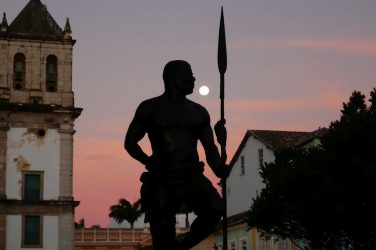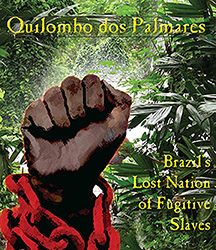
The 1969 kidnapping in Brazil of American ambassador Charles Burke
Elbrick made him a better person. At least that’s what his daughter says now. The story of
the days Elbrick spent in captivity has been told in a film just released. As seen by
director Bruno Barreto the tale is too nonjudgmental to please any side in the ideological
conflict.
By Bondo Wyszpolski
|
"At that time there were some things that many people |
In 1969, the American Ambassador to Brazil was kidnapped in Rio de Janeiro as an act of
protest against the military regime. The dictatorship, which had begun five years earlier
and would last until 1985, had just revoked the rights of the Brazilian citizen and
censured the press. This decree inspired journalist Fernando Gabeira to go underground and
join a resistance group called the October 8th Revolutionary Movement (MR-8).
He would eventually become one of the young and mostly naïve men and women who would grab
Charles Burke Elbrick and hold him hostage. This bold and risky deed accomplished little;
in the long run it was a blip on the screen, a bark in the dark. A decade later, Gabeira
would write a book called O Que É Isso, Companheiro? (What’s Up, Comrade?) that
became the basis for the film Four Days in September—the official Brazilian
entry for the 1997 Academy Awards—, which opened recently in the U.S..
Director Bruno Barreto, whose wildly successful Dona Flor and Her Two Husbands
brought to life the characters in Jorge Amado’s novel of the same name, was in Hollywood
to talk about his new picture. Although Four Days in September may be tagged a
political thriller, it seems much, much more. In fact— "My main preoccupation
was to not fall into the trap of those who tend to divide the world into good and bad,
victim and executioner," Barreto said. "I sought to find the motives of all the
people involved—from the torturer to the kidnappers… I did not make a film about
politics, but about human beings… about the fears, desires, and tensions involved in
a specific episode."
To bring what he had in mind to fruition took Barreto several years. "It was very
hard for me to get this screenplay right, to get a screenplay that would tell the story
from all the different points of view. That’s why I went through six writers, three
American writers, three Brazilian writers, and it ended up taking 10 years. I wouldn’t put
the blame on the writers because I myself was finding my way through it: I knew what I
didn’t want, but I didn’t know how to get what I wanted."
Although he greatly respects Constantin Costa-Gavras and Oliver Stone, and names the
former’s State of Siege and the latter’s Salvador and Born on the Fourth
of July as movies he admires, Barreto had no intention of emulating either man. Having
made films in the United States (A Show of Force; Carried Away, etc.), Barreto was
aware that "had the film been made by a Hollywood studio… it would have
polarized more the dictatorship and the kidnappers." The Brazilian government might
have preferred it, as well as those in the audience who want their celluloid heroes
depicted in black and white, "but it would have been a Hollywood movie because it
would have been [simplified to] good guys versus bad guys."
The director held out for a good script. Actually, it seems, he held out for
scriptwriter Leopoldo Serran, who had already worked with Barreto on Dona Flor.
He’d also knocked off Bye-Bye Brazil for Carlos Diegues and O Quatrilho for
Bruno’s brother Fabio Barreto, the latter film being nominated for an Academy Award for
Best Foreign Film in 1996.
It would have been all too easy, but Barreto didn’t want to take sides, and he didn’t
want to preach. To use film to do so, he says, is irresponsible. Nonetheless, when Four
Days in September was shown in Brazil, a segment of the press "thought the film
had been too soft on the dictatorship."
Few people in this country have a clear understanding of just how bad things became,
especially—as Lawrence Weschler points out in A Miracle, A Universe—during
General Emílio Garrastazu Médici’s presidency (1969-1974) "when torture was at its
worst." And as Nélida Piñon writes in her novel, The Republic of Dreams,
there was in Brazil "from ’68 on, indiscriminate imprisonment and despicable torture.
Young people forced underground, if they didn’t end up dead. There was no constitution to
protect them."
How helpful was Fernando Gabeira, the author of What’s Up, Comrade?? Gabeira,
who in 1992 was elected head of the Green Party in Rio de Janeiro, was shot, captured,
imprisoned and tortured after the Elbrick kidnapping. Not too helpful, Barreto says.
"He tried, but he said, `Bruno, you know, that person died. That was another life
that I had.’… Now he’s a congressman and an activist for the Green Party; he just
didn’t want to open that trunk. He didn’t want to go back there again."
What’s Up, Comrade? doesn’t purport to be a journalistic account of what
transpired during those crucial days of September 4-7. "It’s like an essay,"
says Barreto; "it’s a reflection about what it was like to be a ’60s left wing
militant, and the book is actually very self-critical. That’s what made it so interesting
and new, because he uses the kidnapping of the American in order to review and criticize
the left wing movement in the ’60s that he was a part of. That’s what first attracted me
to the book."
Although Gabeira wants to point out that his character in the movie (played by Pedro
Cardoso) should not be taken as an accurate portrait, he says: "The film tells a
story in which neither the heroes nor the villains are exaggerated and in which they both
are portrayed humanely, which seems to be to be a more modern way of looking at
things."
About its poetic license, Gabeira adds: "I support and defend the film, but I am
not an accomplice to what has been done. The screenplay is not mine, but I think that the
plot is well developed and it has a dignified and non-manichaeistic manner of treating the
subject."
Gabeira also comments on the generation in which he came of age, and the current crop
of young people three decades later: "My generation was, at that time, a continuation
of a tradition of leftist revolution, including the Russian, Chinese, and Cuban
Revolutions. We were attempting to be an heir to this vision of the world in which there
reigned a utopian vision of humanity freeing the persecuted, and to the traditional
division of history into heroes and villains.
"Today the situation is different. Young people do not invest so much in the
future or in long term projects. They are much more preoccupied with the present. In a
way, they are orphans of utopia. Maybe the film can provoke some thought on these
differences, the main one being that at that time there were some things that many people
thought worth giving their lives for."
It’s these concerns, this plunge into ideals and the courage to stand behind them, that
makes Four Days in September a forceful and universal drama. In the film, the role
of Ambassador Elbrick is played by Alan Arkin, perhaps the only recognizable name on the
marquee for American audiences. Although Elbrick has since passed away, the late
ambassador’s daughter, Valerie, proved to be an important source for the development of
Arkin’s on-screen persona.
Barreto and his first scriptwriter had gone to Washington, D.C., to interview her, and
Barreto recalls that—"She said she was at first very jealous of the kidnappers
because they were going to have her dad only for themselves—and she had never had her
dad just for herself… Later, she said, she was angry, she was upset, but in a way she
was thankful because, she said, `My father came back a better human being. And I got a
hug; and I didn’t remember the last time he had hugged me.’"
Elbrick was held for four days and released when, in exchange, the Brazilian military
government agreed to free fifteen political prisoners. Although Elbrick emerged with his
life, his political career wasn’t quite so lucky. The kidnappers, says Barreto, "were
young kids; they weren’t professional terrorists. They had a cause, [and] as Elbrick
understood them, you [the audience] understand them, too."
After the ordeal had ended, and before the hostage-takers were apprehended, Elbrick
spoke at a press conference. He told the media that while he didn’t agree with their
method, he certainly understood the kidnappers’ motivation. "The Brazilian government
hated him from that moment on," Barreto says. They had, after all, bargained for
Elbrick’s life. "He was a very outspoken guy—and he spoke his mind."
Alan Arkin imbues the Elbrick character with dignity and thoughtfulness. Barreto
fleshes him out even more via the letters he is allowed to compose to his wife, Elvira,
played convincingly by Caroline Kava. I do not know if the existence of these pensive,
perceptive letters has any basis in reality—Barreto did not say—but they temper
the film and enhance its introspective qualities.
For all this, the audience may sympathize as much, and perhaps even more, with the
kidnappers themselves. The actors elicit our interest and compassion, and it’s clear that
the director has an eye for nuances within and in between characters. When Barreto says he
worked hard to steer this project away from resembling a Hollywood movie, the successful
result of his endeavor is plain to see. This writer recently caught two James Cameron
films (The Abyss; Titanic), and what’s up there on the screen? Black and white,
good guys and bad. With Four Days in September we see that life is a field of
grays—even in what may at first glance appear to be a cut-and-dried situation.
"It was the hardest film I have ever cast," Barreto says, "because it
was the first ensemble piece I directed. I not only had to cast the right actor in the
right part, I had to make sure the chemistry worked among them. It was like a chess game,
all the combinations that could have happened… I just wanted to make sure that there
wasn’t going to be one false note. If there is one little character who opens a door and
then delivers a short line badly, the whole magic is gone."










